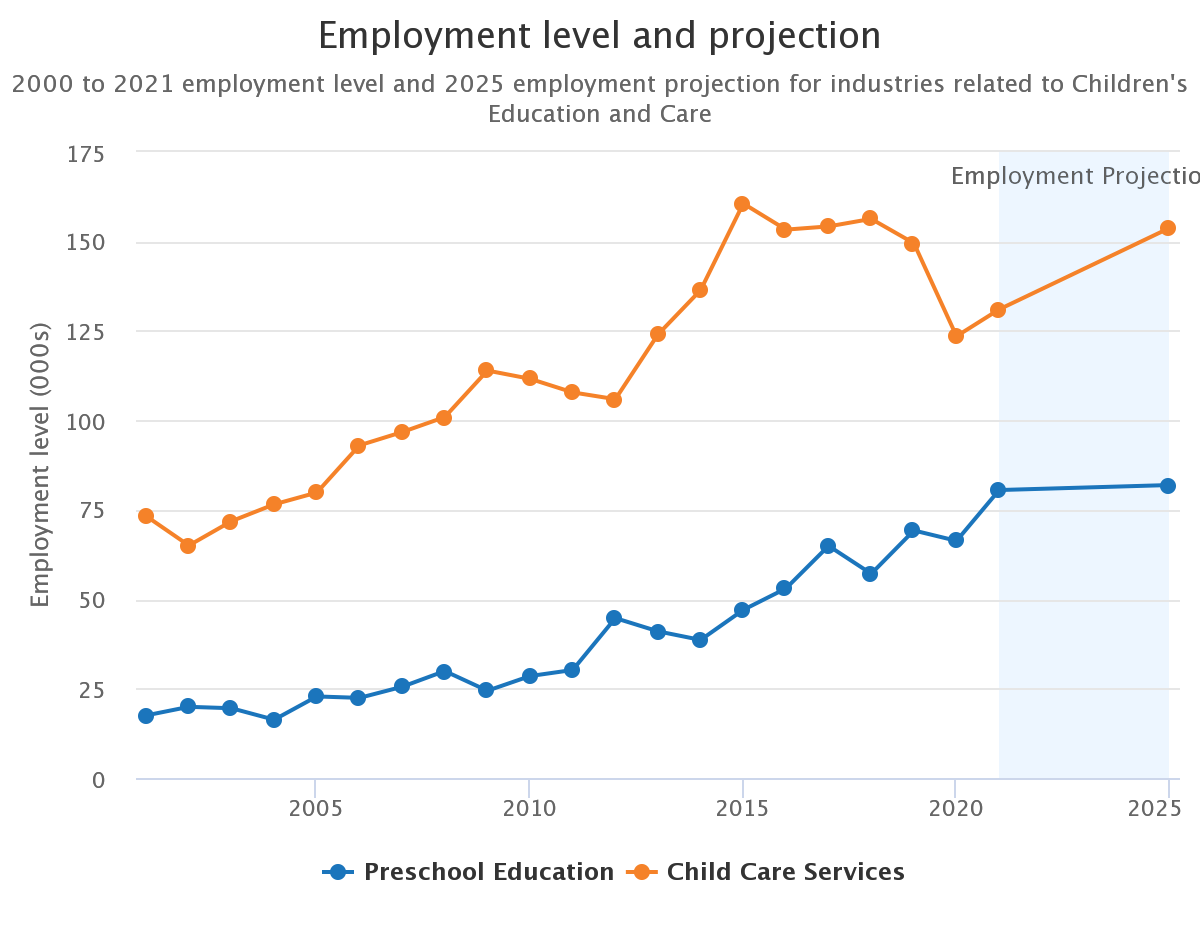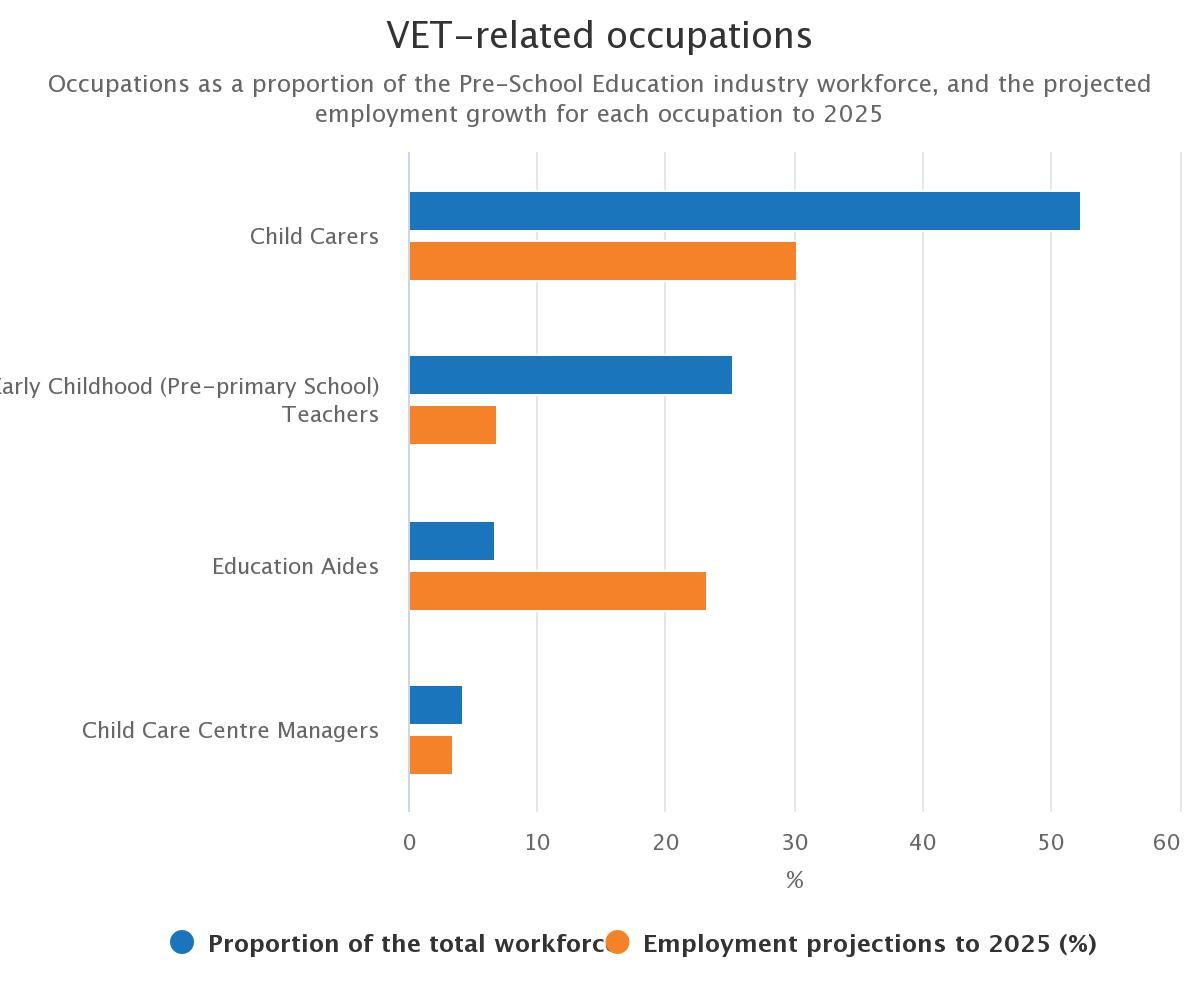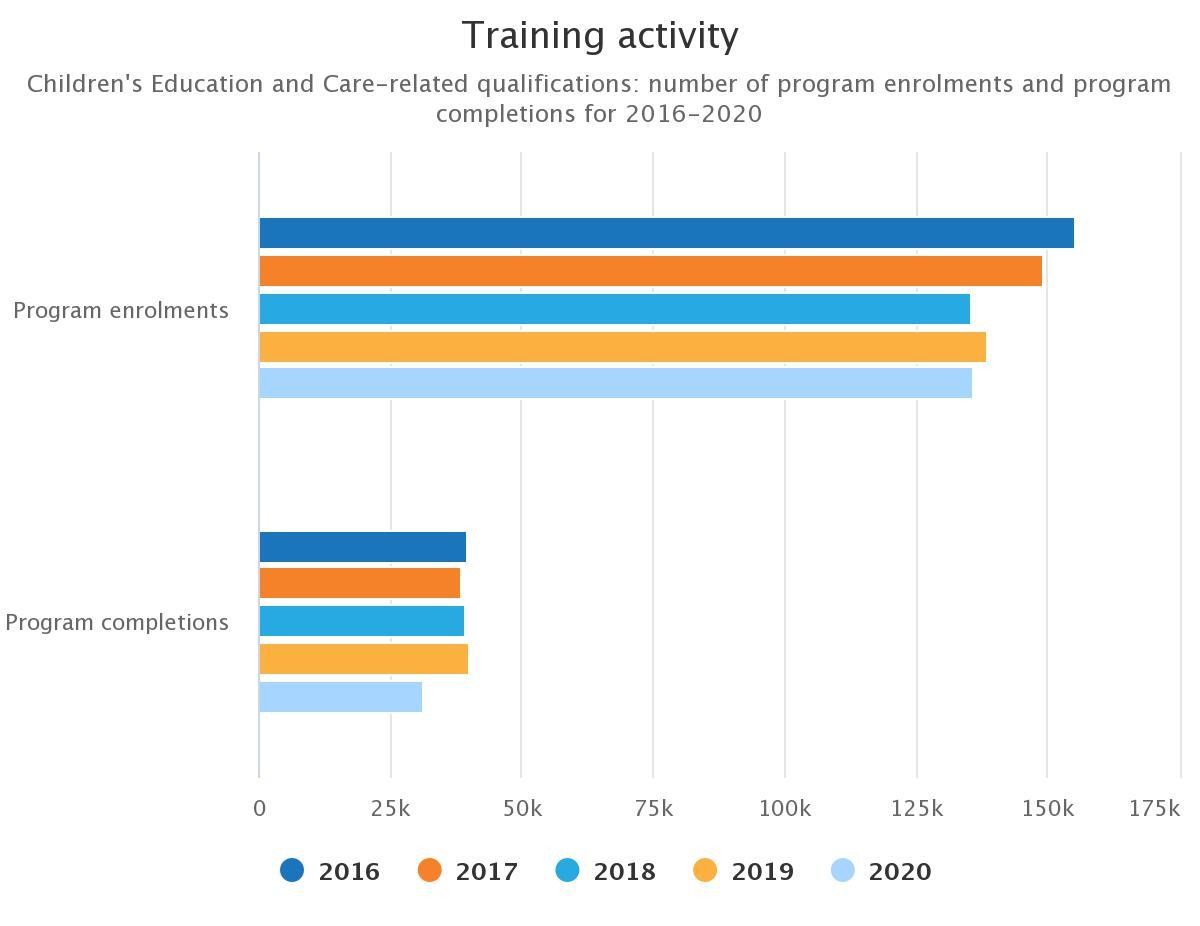Executive Summary
The given report is for the council to provide a comprehensive overview of the current state of the early childhood profession in Australia by outlining its strengths and issues. The document provides justifications based on evidence to substantiate the core recommendation of why it is critical to facilitate the adoption of direct support and funding for community-based early childhood education services. The existing state of the early childhood profession in Australia is well-designed and well-established for the learners themselves, but there are substantial problems in the domains of talent attraction and retention. The trends indicate that experienced early childhood professionals are leaving the field in large numbers.
The movement of the trend points towards an unappealing direction of less influx of educational labour illustrated by lower training completions. The assessment of the legislative suggests that there is a lack of cohesiveness among different obligatory and foundational documents. The first recommendation is to address wage dissatisfaction since it was identified as among the biggest reasons for talent management problems. In other words, the resources need to reach the hands of professionals fully, which is why assisting the communities and their educators directly can be effective. The second recommendation is to revise the current legal and policy-based framework for cohesiveness. The three identified policies and legal obligations can be carefully redesigned to ensure that professionals are not operating under restrictive frameworks to enable a greater degree of freedom to integrate effective teaching practices.
Introduction
It is important to note that any improvement and adjustment measure on a complex domain, such as education, requires a thorough analysis of its current state, dynamics, and trends. The given report will primarily focus on the current state of the Australian early childhood profession with an emphasis on the existing challenges, strengths, and directional changes. The recommendations and observations are centred around the Early Years Learning Framework, which is a curriculum designed to enhance children’s development aged during the first years of a person’s life. The framework will provide both insights and comparative metrics to the modern problems affecting early childhood professionals throughout the nation. The current system of the Australian early childhood profession is well-designed for the children but has major issues in regard to talent retention and management on the basis of recent trends and their subsequent trajectories.
Terms of Reference
Key terms used in the report are shown in the Table 1 below.
Table 1. Key terms of reference. Note. Created by the author.
Report: Main Body
Early Childhood
Understanding the intricacies of the early childhood profession needs one to comprehend what the given stage of human development entails. In Australia, early childhood is a stage of human growth and development from birth to eight years old (Capital Health Network, 2017). It is a highly sensitive and critical time period, which is deeply and profoundly influential for a person’s future life. It is a period when “rapid brain growth and development and the benefits of exposure to high-quality early years learning and development opportunities has lasting impacts … to the individual child across their lifetime” (Capital Health Network, 2017, p. 3). In other words, ensuring that children have access to quality education not only develops quicker in a healthy manner but additionally provides them with a solid foundation for their future development.
Early Years Learning Framework
In order to properly and systematically discuss and analyse the existing state, issues, and future directions of early education in Australia, it is critical briefly review the Early Years Learning Framework. EYLF is “a guide to help educators and caregivers support their children from birth to five years old” (Twinkl, 2022, para. 2). Its core objective is to “assist educators in providing young children with opportunities to maximise their potential and develop a foundation for future success in learning” (Twinkl, 2022, para. 2). On the basis of the information provided in the paragraph above, the document realises the criticality of the early childhood, which is why it seeks to provide best possible start in one’s life.
The major elements of the EYLF include 3Bs, which determines the fundamental approach utilised by the framework, and these are Belonging, Being, and Becoming. The former is about signifying “a child’s ability to make relationships and acknowledging their cultural identity. Children need to know where they belong to know what they can be or become” (Twinkl, 2022, para. 7). Thus, the cultural identity of children is relevant for their development to feel as a part of a larger group. Being refers to self-understanding and self-awareness of a child’s competence as well as courage to face life’s challenges and complexities (ACECQA, 2018). Becoming encompasses the shaping and transformation of children in regards to their “identities, knowledge, understandings, capacities, skills and relationships” (ACECQA, 2018, p. 7). The emphasis needs to be put on the acknowledgement of the rapidity of their growth and development, which makes it vital to provide them with the necessary skills and knowledge to enable their greater societal contribution.
Characteristics of The Early Childhood Profession
The early childhood profession is characterised by three categories of qualifications. These include certificate III level qualifications, diploma level qualifications, and early childhood teaching qualifications (ACECQA, 2022a, para. 2). The qualifications outside these metrics can be checked for equivalency with the assistance of ACECQA. An example of Certificate III level qualification would be the Advanced Certificate Course from Montessori World Education (ACECQA, 2022b, para. 16). However, “any Australian registered training organisation or accredited higher education provider” can qualify at a diploma level, such as Diploma of Community Services (ACECQA, 2022b, para. 16). Thus, the early childhood professionals require either certificates, diplomas, or teaching qualifications. They can be leaders, teachers, or educators, depending on their competencies and qualifications.
Complexities of The Early Childhood Profession
Working in the early childhood professional field is a multifaceted and complex endeavour. Such an individual needs to be highly organised, energetic, creative, respectful to both families and children, authentic, passionate, quick to learn, and communicative (Department of Education, 2021). Not only the early childhood professional is required to be properly and sufficiently qualified with verifiable documents, but he or she must have specific personal skills and qualities to provide a quality early life education as well. The listed skills and qualities are critically important for an educator’s success in the field, which is highly complex in their attribution and execution.
Current Strengths
One should be aware that the current advantages of the early childhood profession in Australia are numerous and substantial. Firstly, the Australian system of education is highly precise in catering to the children’s and learners’ needs due to a thorough age segmentation. Australian curriculum acknowledges and knows the educational needs of the learner in each phase, which is why the current early childhood profession is potent. Secondly, it further distinguishes between preschool and childcare, where each domain is properly managed (Australian Institute of Health and Welfare, 2022). Thirdly, early childhood professionals work on not only academic knowledge but rather comprehensive development, such as skills in expressing one’s thoughts. It encourages children to become curious, socially competent, persistent, concentrated, and well-adapted with appropriate behaviours (Australian Institute of Health and Welfare, 2022). Fourthly, the early childhood profession established a solid and strong foundation for children’s future successes starting with school and beyond (NSW Government, 2022). Therefore, the current early childhood education in Australia is powerful and well-designed.
Current Challenges
Despite the fact that the system is generally well-established for children, for the most part, the entirety of the framework contains several major flaws. Firstly, the biggest challenge in the early childhood profession is talent retention and attraction (Riley, 2021). Many educators working in the given field are dissatisfied “with wages, feeling unappreciated by the community for their role as early educators” (Riley, 2021, para. 3). Secondly, the weakness of the current education system is the lack of opportunities for future professional growth among teachers (Riley, 2021). Thirdly, it is reported that “public policy is quite conflicted, it’s got contradictory constructions of children depending on the arena in which it’s acting” (Cortis & Head, 2019, p. 6). In other words, there is no cohesiveness within the policies and legal instruments when it comes to regulating the field.
Fifthly, the leadership in the education system can be considered as weak. The latter statement is based on recent reports from professionals working in the field (Cortis & Head, 2019). Thus, it becomes evident that the systematic flaws of the Australian early childhood professional can be observed in the domain of professionals. Although one might assume that children’s needs are still properly and sufficiently catered to, it is important to remind the fact that children’s success is heavily reliant on the educator.
Trends and Movements

Trends
The recent and current trends in the Australian early childhood profession are most problematic in regard to the workforce. The general positive projections for employment in children’s education and care show static numbers for preschool education, as shown in Figure 1 above. However, the problem becomes more highlighted in its severity due to rapid labour shortages among early childhood teachers, whose employment rates have dropped substantially and are expected to do in the near future (Australian Industry and Skills Committee, 2021). The trend data is demonstrated in Figure 2 below.

Movements
For the movements, the direction of the presented trends is expected to become even worse. The latter becomes more apparent when one looks into training data movements across time and resource allocations, as shown in Figure 3 below. The estimation of the direction of the movement shows that fewer people are pursuing the early childhood education profession (Australian Industry and Skills Committee, 2021). The latter, accompanied by experienced professionals leaving the field, can compound into a severe labour shortage.

International Context Comparison
Although the Australian early childhood professional field is performing better than the average among all nations, it still lags behind top performers, such as Norway. For example, it is stated that “compensation of teachers and other staff employed in educational institutions represents the largest share of current expenditure” (OECD, 2021, para. 30). This alone can explain why Australian early childhood professionals express their dissatisfaction with wages and are leaving the field, whereas no such trend is observable in Norway.
Key Legal Obligations and Policies
Obligations and Policies
When it comes to the early childhood profession in Australia, there are three major legal and policy-based obligations relevant to the field. Firstly, it is stated that NQF “provides a national approach to regulation, assessment and quality improvement for early childhood education and care and outside school hours care services across Australia” (ACECQA, 2022c, para. 1). Secondly, the Early Childhood Australia’s Code of Ethics is “a set of statements about the appropriate and expected behaviour of early childhood professionals” (Early Childhood Australia, 2022, para. 1). Thirdly, the United Nations Convention on the Rights of the Child applies to the field as well. Its central claim is “that children are not just objects who belong to their parents and for whom decisions are made, or adults in training” (UNICEF, 2022, para. 6). These three core documents act as the pillars of the Australian early childhood professional standards of practice.
Implications for Teaching and Service Provision
The implications of the stated obligations and policies on teaching are massive. They prevent any unprofessional conduct and harm to children in all domains of the educational process. However, they lack coherence with one another, which can make the delivery of the service and its provision a complex and challenging task. The impact might not affect learners directly, but the indirect effect takes place with teacher and educator shortages unwilling to operate under strict terms with no significant reward incentives.
SWOT Analysis
SWOT
The SWOT analysis for the report on the early childhood profession is shown in Table 2 below.
Table 1. Key terms of reference. Note. Created by the author.
Justifications and Risks
On the basis of the SWOT analysis as well as discussions provided above, the current early childhood education system in Australia is ideally designed to fit the needs of children in a comprehensive manner. The education not only develops children academically but additionally enhances their competencies in other critical domains, such as emotional and social developments. However, its recent trends indicate massive risks with talent attraction and retention, which can result in labour shortages leading to an overload of the education system’s capacity and subsequent dysfunctionality or collapse.
Therefore, it is important for the council to support and fund community-based ECE services. Investing and assisting communities directly by increasing the compensation for early childhood professionals can minimise the negative impact of employee dissatisfaction. In addition, direct funding and bolstering of the wages can attract more talent willing to undergo the extensive training process established in Australia. One should be aware that teacher pay, especially among early childhood professionals, is among the most common problems affecting the field across multiple nations (Whitty & Furlong, 2017). The most effective solution is to allow the additional funds to reach the educators and teachers directly by investing in community-based early childhood education services.
Conclusion and Recommendations
Conclusion
In conclusion, the current state of the early childhood profession in Australia is well-designed and well-established for the learners themselves, but it contains major flaws in the area of talent management, especially attraction and retention. The early childhood stage of human development is among the most foundational phases, which can determine the future success and failures of an individual. The effects of such an educational endeavour are longitudinally lasting for a person’s entire lifetime. The Australian childhood education system is heavily segmented, which allows it to focus on the precise developmental needs of each learner. In addition, it can be considered systematic and comprehensive since it not only promotes academic development but socioemotional development as well.
However, there are substantial problems in the domains of talent attraction and retention. The trends indicate that experienced early childhood professionals are leaving the field in large numbers. The movement of the trend points towards an unappealing direction of less influx of educational labour illustrated by lower training completions. The assessment of the legislative suggests that there is a lack of cohesiveness among different obligatory and foundational documents, policies, and legal instruments, making the teacher experience even more challenging.
Recommendations
The core recommendation on the basis of data obtained through the given report can be divided into two major categories. Firstly, it is critical to revise the current legal and policy-based framework in order to ensure cohesiveness of teacher obligations in order to enable a great range of freedom to cater to the children’s needs. It needs to take place without affecting the factors making it highly successful in serving the learners. Secondly, the most significant recommendation is to facilitate the adoption of direct support and funding for community-based early childhood education services. Wage dissatisfaction was identified as among the biggest reasons for talent management problems. The resources need to reach the hands of professionals fully, which is why assisting the communities and their educators directly can be effective.
References
ACECQA. (2018). Belonging, being & becoming: The Early Years Learning Framework for Australia [PDF document]. Web.
ACECQA. (2022a). Early childhood qualification assessment. Web.
ACECQA. (2022b). Check your qualification is NQF approved. Web.
ACECQA. (2022c). What is the NQF? Web.
Australian Industry and Skills Committee. (2021). Children’s education and care. Web.
Australian Institute of Health and Welfare. (2022). Australia’s children: Early childhood education and care. Web.
Capital Health Network. (2017). Early childhood, middle years and youth [PDF document]. Web.
Cortis, N., & Head, B. (2019). Tensions and challenges in Australia’s early years field: Views from the inside [PDF document]. Web.
Department of Education. (2021). Qualities of great early childhood educators.Web.
Early Childhood Australia. (2022). Code of Ethics. Web.
NSW Government. (2022). Benefits of early childhood education. Web.
OECD. (2021). Norway. Web.
Riley, S. (2021). Early childhood education sector faces challenges now and post-pandemic. Web.
Twinkl. (2022). Early Years Learning Framework. Web.
UNICEF. (2022). Convention on the rights of the child. Web.
Whitty, G., & Furlong, J. (2017). Knowledge and the study of education: An international exploration. Symposium Books.